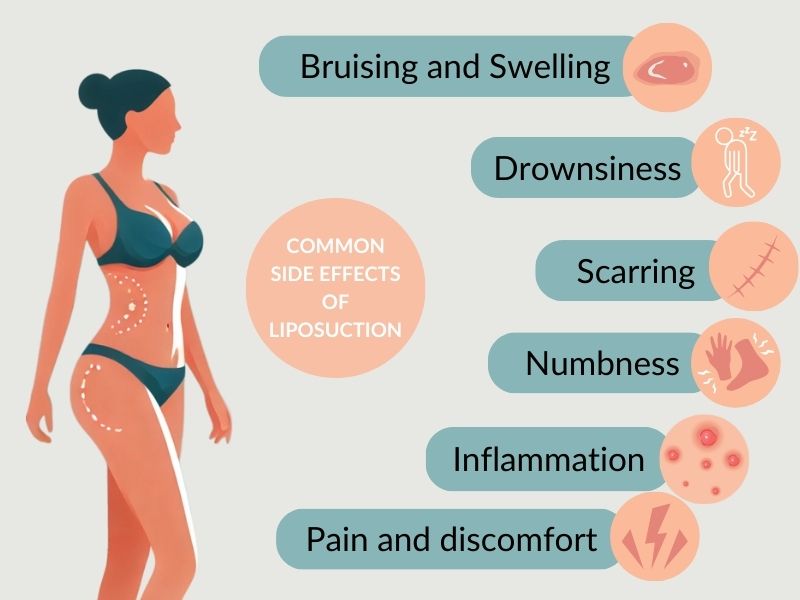Liposuction Side Effects

Liposuction is a popular cosmetic procedure designed to remove excess fat deposits from specific areas of the body. While many people undergo liposuction to achieve a more sculpted and contoured appearance, it is essential to understand the potential side effects and complications associated with this procedure. As a surgeon, it is crucial to inform patients about these risks to ensure they make an informed decision.
Common Side Effects After Liposuction
After undergoing liposuction, it is common for patients to experience several side effects. These are usually temporary and should subside within a few weeks to months:
Bruising and Swelling: Bruising and swelling are normal post-operative effects that can last up to six months. The extent of bruising and swelling varies depending on the area treated and the amount of fat removed.
Numbness: Patients may experience numbness in the treated area, which generally resolves within six to eight weeks. This is due to the temporary disruption of nerve endings during the procedure.
Scars: Although liposuction incisions are small, they can leave scars. These scars usually fade over time but may remain visible in some cases.
Inflammation: Inflammation of the treated area or the veins underneath is common and should decrease as the body heals.
Fluid Discharge: Fluid may ooze from the cuts made during liposuction. This is typically normal and part of the healing process.
Swollen Ankles: If the legs or ankles are treated, patients might experience swelling in these areas. This should improve as the body recovers.
Potential Complications After Liposuction
Although liposuction is generally safe, complications can occasionally arise. However, choosing an experienced surgeon will minimize these risks.
Lumpy and Uneven Results: Some patients may end up with lumpy or uneven skin due to irregular fat removal. This can often be corrected with additional procedures.
Haematoma: Bleeding under the skin, known as a haematoma, can occur. This may require medical intervention to resolve.
Persistent Numbness: In rare cases, numbness can persist for several months or even longer.
Skin Discoloration: Changes in skin color in the treated area can happen, although this is usually temporary.
Pulmonary Oedema: A build-up of fluid in the lungs, known as pulmonary oedema, can result from the fluids injected into the body during liposuction. This is a serious condition that requires immediate medical attention.
Pulmonary Embolism: A blood clot in the lungs, or pulmonary embolism, is a rare but severe complication. Symptoms include sudden shortness of breath and chest pain, necessitating urgent medical care.
Internal Organ Damage: Though extremely rare, damage to internal organs during liposuction can occur if the cannula used for fat removal penetrates too deeply.
General Surgical Risks
As with any surgical procedure, liposuction carries general risks, including:
Excessive Bleeding: All surgeries carry a risk of bleeding, and liposuction is no exception.
Blood Clots: Developing a blood clot in a vein (deep vein thrombosis) can be life-threatening if it travels to the lungs.
Infection: Post-operative infections are a risk with any surgery and require prompt treatment.
Allergic Reactions: Some patients may have allergic reactions to the anaesthetic used during the procedure.
Managing Risks and Complications
Before undergoing liposuction, your surgeon should explain the likelihood of these risks and how they would be treated if they occur. It is essential to have realistic expectations and to follow all pre- and post-operative instructions carefully.
Addressing Problems Post-Liposuction
If you experience severe pain or any unexpected symptoms after liposuction, contact the clinic where the procedure was performed as soon as possible. Early intervention can prevent complications from worsening.
If you are unhappy with the results of your liposuction or feel that the procedure was not performed correctly, you should discuss your concerns with your surgeon. Most clinics have protocols for handling such issues, and additional treatments or corrective surgeries may be recommended.
In conclusion, while liposuction can provide significant aesthetic benefits, it is important to be aware of the potential side effects and complications. Thoroughly discussing these risks with your surgeon will help ensure you are well-prepared and can achieve the best possible outcome from your liposuction procedure.
 Turkish
Turkish